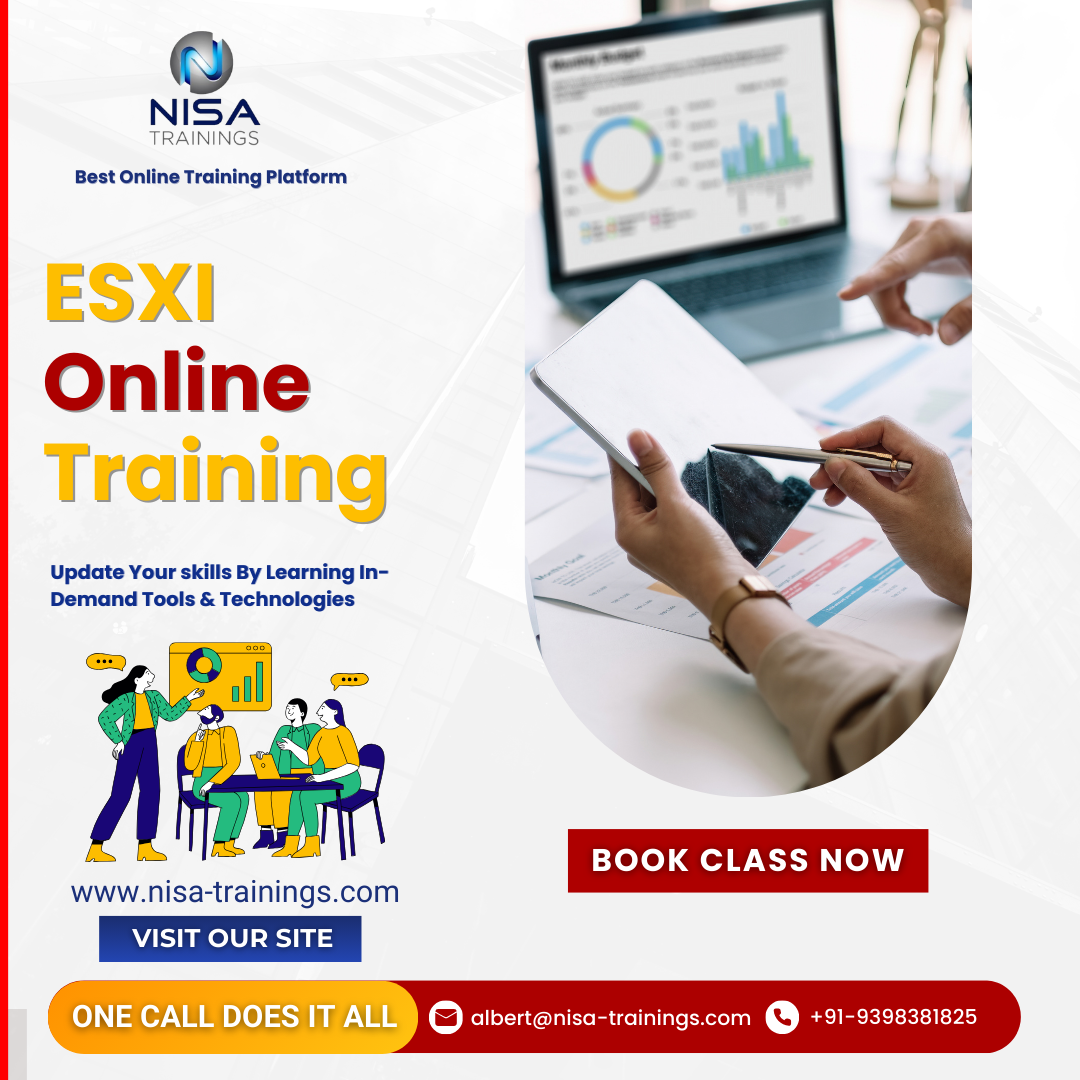ESXI Training
Categories
Other Courses
Course level:Intermediate
ESXi (VMware ESXi) is a type of bare-metal hypervisor that is used to create and manage virtual machines (VMs) on physical servers. It is a key part of VMware’s vSphere suite, providing the underlying virtualization layer to run virtual environments.

Why should you choose Nisa For ESXI Training?
Nisa Trainings is the best online training platform for conducting one-on-one interactive live sessions with a 1:1 student-teacher ratio. You can gain hands-on experience by working on near-real-time projects under the guidance of our experienced faculty. We support you even after the completion of the course and happy to clarify your doubts anytime. Our teaching style at Nisa Trainings is entirely hands-on. You’ll have access to our desktop screen and will be actively conducting hands-on labs on your desktop.
Job Assistance
If you face any problem while working on ESXI Course, then Nisa Trainings is simply a Call/Text/Email away to assist you. We offer Online Job Support for professionals to assist them and to solve their problems in real-time.
The Process we follow for our Online Job Support Service:
- We receive your inquiry for Online Job
- We will arrange a telephone call with our consultant to grasp your complete requirement and the tools you’re
- If our consultant is 100% confident in taking up your requirement and when you are also comfortable with our consultant, we will only agree to provide service. And then you have to make the payment to get the service from
- We will fix the timing for Online Job Support as mutually agreed by you and our consultant.
Course Information
ESXI Training
Duration: 25 Hours
Timings: Weekdays (1-2 Hours per day) [OR] Weekends (2-3 Hours per day)
Training Method: Instructor Led Online One-on-One Live Interactive
Sessions.
COURSE CONTENT :
1. Introduction to VMware ESXi
- What is ESXi? Overview of VMware ESXi, its components, and role in virtualization.
- Hypervisor types: Difference between Type 1 (bare-metal) and Type 2 (hosted) hypervisors.
- Installing ESXi: How to install VMware ESXi on physical hardware.
- Hardware Compatibility: Understanding ESXi’s hardware compatibility requirements (CPU, RAM, storage).
2. ESXi Architecture
- ESXi Host Structure: Understanding the architecture of ESXi, including the VMkernel, service console, and hypervisor.
- Resource Management: How ESXi allocates resources like CPU, memory, and storage to virtual machines.
- Datastores and Storage: Configuring datastores and managing storage resources.
3. Managing ESXi via vSphere Client
- vSphere Client Overview: Introduction to VMware vSphere Client for managing ESXi.
- Accessing and Managing Hosts: Connecting to ESXi hosts, creating, and managing VMs.
- Host Configuration: Networking settings, time synchronization, and hardware monitoring.
4. Networking in ESXi
- Virtual Networks: Understanding virtual switches (vSwitches), VLANs, and port groups.
- Physical Network Adapters: Configuring NICs, bonding, and failover policies.
- Network Troubleshooting: Diagnosing network issues in ESXi hosts.
5. Storage Configuration
- Local vs. Shared Storage: Understanding the differences and when to use each type.
- Creating and Managing Datastores: Adding and configuring datastores.
- iSCSI, NFS, and Fibre Channel: Storage protocols and how to configure them in ESXi.
6. Creating and Managing Virtual Machines
- Creating Virtual Machines: Setting up VMs, choosing hardware configurations, and installing guest operating systems.
- VM Snapshots and Clones: Creating and managing snapshots and clones of virtual machines.
- VMware Tools: Installing and using VMware Tools for better performance and management inside VMs.
7. Security in ESXi
- User Management: Adding and managing users and roles on ESXi hosts.
- Firewalls and Security Settings: Configuring firewall settings and other security options.
- Audit and Logging: How to enable and review logs for troubleshooting and security monitoring.
8. Resource Management and Performance Monitoring
- CPU and Memory Management: Configuring CPU and memory allocation for VMs and hosts.
- Resource Pools: Using resource pools to manage resource allocation across VMs.
- Monitoring Performance: Using tools like ESXTOP and the vSphere Client to monitor performance.
9. Backup and Disaster Recovery
- VM Backup Methods: Understanding the different methods of backing up virtual machines.
- vMotion and DRS (Distributed Resource Scheduler): How to move VMs between hosts without downtime.
- Fault Tolerance and High Availability: Implementing and configuring HA and FT for high uptime.
10. Advanced Features (Optional)
- vSphere HA & DRS: Advanced features for clustering and load balancing.
- vCenter Server: How to use vCenter for centralized management of ESXi hosts.
- Automation with PowerCLI: Using VMware’s command-line tools for scripting and automation.

